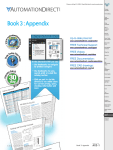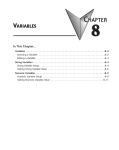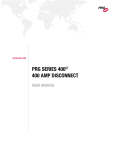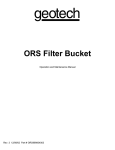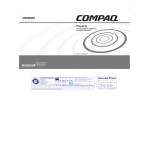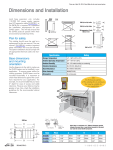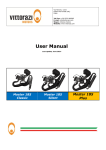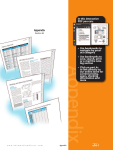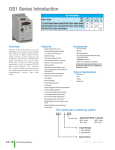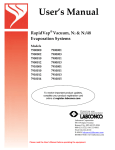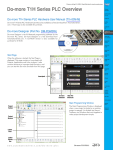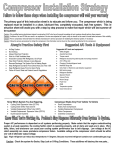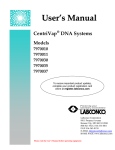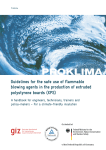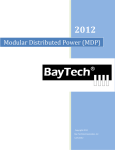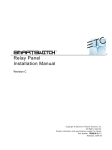Download ISO 9001/UL/CUL/EU/RoHS
Transcript
Prices as of April 16, 2014. Check Web site for most current prices. ISO 9001/UL/CUL/EU/RoHS Throughout the world, there is a wide variety of regulatory codes, agency approvals, and other types of certification that may be required in order to install an automation system. These requirements vary and depend on your exact location and situation. For example, there may be national codes, state and local government codes, and even wide-ranging requirements such as the European Union (EU) Directives. The following are some of these codes and requirements, and explanations of how they may affect you as a PLC and industrial controls user. ISO 9001 Some companies require their suppliers to use products that are built by companies that adhere to a documented set of quality-related procedures. ISO 9001 is one of the standards in the ISO 9000 family of standards for quality management systems. Koyo Electronics Industries Company, Ltd., the manufacturer of most of our PLC products, is an ISO 9001 certified company, as are many of our other Federation members. Underwriters Laboratories (UL/CUL) Underwriters Laboratories is one of the world’s premier safety testing and certification sources. Many applications require UL approval for insurance and/or other compliance purposes. There are several areas of interest, but the most applicable are: UL508, the standard for Industrial Control Equipment; and UL1604, the standard covering Hazardous Locations. For more information on the Underwriters Laboratories, check their Web site at www.ul.com. There are several tables in this section that show which of our products have a UL listing. (They also indicate the cUL approval, which is required in many applications in Canada.) Please check our Web site for the most current information. European Union (EU) Directives This area of certification and approval is absolutely vital to anyone who wants to do business in Europe. One of the key tasks that faced the EU member countries and the European Economic Area (EEA) was the requirement to bring several similar, yet distinct, standards together Book 1 (14.1) eAX-4 Book 1: Appendix into one common standard for all members. The primary purpose of a single standard was to make it easier to sell and transport goods between the various countries and to maintain a safe working and living environment. The Directives that resulted from this “harmonization” of standards are now legal requirements for doing business in Europe. Products that meet these Directives are required to have a CE mark to signify compliance. A few key questions are always asked when the subject of CE is discussed. Which Directives apply to me? Several Directives apply to our products, and Directives may be amended or added, as required. • Electromagnetic Compatibility Directive (EMC) – Provides a means to ensure that products placed on the market do not generate electromagnetic disturbances that would affect other apparatus, including radio and/or telecommunications equipment. • Machinery Safety Directive – Covers the safety aspects of the equipment, installation, etc. There are several areas involved, including testing standards covering both electrical noise immunity and noise generation. • Low Voltage Directive – Is also safety related and covers electrical equipment that has voltage ranges of 50-1,000 VAC and/or 75-1,500 VDC. • Battery Directive – Covers the production, recycling, and disposal of batteries. Who is responsible for ensuring compliance with these Directives? Ultimately, we are all responsible for our various pieces of the puzzle. Manufacturers must test their products and document any test results and/or installation procedures necessary to comply with the Directives. As a machine builder, you are responsible for installing the products in a manner that will ensure compliance is maintained. You are also responsible for testing any combinations of products that may (or may not) comply with the Directives when used together. The end user of the products must comply with any Directives that may cover maintenance, disposal, etc. of equipment or various components. Although we strive to provide the best assistance available, it is impossible for us to test all possible configurations of the products we carry with respect to any specific Directive. Because of this, it is ultimately your responsibility to ensure that your machinery (as a whole) complies with these Directives and to keep up with applicable Directives and/or practices that are required for compliance. Which programmable controller products carry the CE label? See Tables on pp. 35-11 through 35-14 for controller systems manufactured by Koyo Electronics Industries, Host Engineering or FACTS Engineering. When properly installed and used, the approved components conform to the Electromagnetic Compatibility (EMC), Low Voltage Directive, and Machinery Directive requirements of the standards on the next page. EC 61000-3-2 Power Factor Correction The IEC 61000-3-2 standard is intended to reduce the amount of disturbance a device feeds back into its power source. AutomationDirect power supplies all carry the CE mark. Normally, 61000-3-2 is met or does not apply. Only our PS24150D and PS24-300D could potentially be used in a manner not compliant with the 61000-3-2 standard. RoHS The Restriction of Hazardous Substances (RoHS) Directive 2002/95/EC [1] was adopted in February 2003 by the EU. The RoHS directive, which took effect July 1, 2006, restricts the use of six hazardous materials in the manufacture of various types of electrical and electronic equipment. RoHS is linked with the Waste Electrical and Electronic Equipment Directive (WEEE) 2002/96/EC which sets collection, recycling and recovery targets for electrical goods and is part of a legislative initiative to solve the problem of large amounts of toxic e-waste. Each EU member state will adopt its own enforcement and implementation policies using the directive as a guide. Therefore, there could be as many different versions of the directive as there are states in the EU. RoHS is often referred to as the lead-free directive, however, it restricts the use of the following six substances: •Lead •Mercury •Cadmium •Hexavalent chromium (chromium VI or Cr 6+) •Polybrominated biphenyls (PBB) •Polybrominated diphenyl ether (PBDE) For a listing of all products and their compliance status see: http://support.automationdirect.com/ compliance.html#rohs 1-800-633-0405 Prices as of April 16, 2014. Check Web site for most current prices. Company Information EU - European Union • EMC Directive Standards Relevant to PLCs E N50081-1 – Generic emission standard for residential, commercial, and light industry E N50081-2 – Generic emission standard for industrial environment E N50082-1 – Generic immunity standard for residential, commercial, and light industry E N50082-2 – Generic immunity standard for industrial environment • Low Voltage Directive Standards Applicable to PLCs E N61010-1 – Safety requirements for electrical equipment for measurement, control, and laboratory use • Product Specific Standard for PLCs EN61131-2 – Programmable controllers, equipment requirements and tests. This standard replaces the above generic standards for immunity and safety. However, the generic emissions standards must still be used in conjunction with the following standards: E N 61000-3-2 – Harmonics E N 61000-3-2 – Fluctuations. We are currently in the process of changing our testing procedures from the generic standards to the product specific standards. We do have separate Declarations of Conformity that cover the specific products and part numbers approved. Not all of the products have been labeled for CE as of this writing, so you should check the tables on the following pages to be sure. Please also check our Web site for the most up-to-date information on CE approvals or to obtain copies of our Declarations of Conformity. Are there any special requirements necessary when using controller equipment? Yes, the installation requirements to comply with the requirements of the Machinery Directive, EMC Directive and Low Voltage Directive are slightly more complex than the normal installation requirements found in the United States. First, check the Declaration for specific application conditions required. Then, refer to the following manual: • DA-EU-M – EU Installation Manual that covers special installation requirements to meet the EU Directive requirements. You should download the manual from our Web site to obtain the most current information. The manual is available for download at: support.automationdirect.com/ compliance.html Finally, check your user manual for EU information. Are there any other sources of information? Although the EMC Directive gets the most attention, other basic Directives, such as the Machinery Directive and the Low Voltage Directive, also place restrictions on the control panel builder. Because of these additional requirements, it is recommended that the following publications be purchased and used as guidelines: • BSI publication TH42073: February 1996 – Covers the safety and electrical aspects of the Machinery Directive • EN60204-1:1992 – General electrical requirements for machinery, including Low Voltage and EMC considerations • IEC 1000-5-2: EMC earthing and cabling requirements • IEC 1000-5-1: EMC general considerations It may be possible for you to obtain this information locally. However, the official source of applicable Directives and related standards is: The Office for Official Publications of the European Communities at www.europa.eu.int Another source is: Global Engineering Documents 15 Inverness Way East Englewood, CO 80112-5776 1(800) 854-7179 (within the U.S.) (303) 397-7956 (international) (303) 397-2740 (fax) www.global.ihs.com Control Systems Overview The information contained in this section is intended as a guideline and is based on our interpretation of the various standards and requirements. Since the actual standards are issued by other parties and in some cases Governmental agencies, the requirements can change over time without advance warning or notice. Changes or additions to the standards can possibly invalidate any part of the information provided in this section. Do-More PLCs Overview Do-More H2 PLC Do-More T1H PLC DirectLOGIC PLCs Overview DirectLOGIC DL05/06 DirectLOGIC DL105 Books Following is a list of books that may be helpful to you: Title: EMC For Systems and Installations Authors:Tim Williams and Keith Armstrong Publisher: Newnes Woburn, MA Title: CE From A to Z Authors:Mette Winther Pedersen & Gert Bukkjaer Publisher: Levison & Johnson & Johnson a/s Denmark Title: EU Directive Handbook: Understanding the European Union Compliance Process and What it Means to You Authors:Allen R. Bailey & Melinda C. Bailey Publisher: St. Lucie Press Boca Raton, FL Title: Practical Guide to the Low Voltage Directive Authors:Gregg Kervill Publisher: Newnes Woburn, MA Title: C E Marking Handbook: A Practical Approach to Global Safety Certification Authors:David Lohbeck Publisher: Newnes Woburn, MA Book 1 (14.1) www.automationdirect.com CLICK PLC Book 1: Appendix eAX-5 DirectLOGIC DL205 DirectLOGIC DL305 DirectLOGIC DL405 Productivity Controller Overview Productivity 3000 Universal Field I/O Software C-More HMI C-More Micro HMI ViewMarq Industrial Marquees Other HMI Communications Appendix Book 1 Terms and Conditions Prices as of April 16, 2014. Check Web site for most current prices. NEC and NEMA The National Electrical Code (NEC) NEC provides regulations concerning the installation and use of various types of electrical equipment. These classifications are being “harmonized” with the IEC and European Hazardous Location Ratings. A source of information about this “harmonization” is the Instrument Society of America (ISA). Contact the ISA at: 67 Alexander Drive RTP, NC 27709 Phone: (919)549-8411 www.isa.org Another resource is: www.ul.com/hazloc National Electrical Manufacturers Association (NEMA) NEMA publishes many different documents that discuss standards for industrial control equipment. Please note that these standards are undergoing “harmonization” with the IEC and European standards and may be replaced. Global Engineering Documents handles the sale of NEMA, IEC and CE documents. For more information, please contact Global Information at: 1 (800) 854-7179 (within the U.S.) (303) 397-7956 (international) (303) 397-2740 (fax) 15 Inverness Way East Englewood, CO 80112-5776 www.global.ihs.com • ICS 1, General Standards for Industrial Control and Systems • ICS 2, Controllers, Contactors, and Overload Relays, Rated no more than 2000 Volts AC or 750 Volts DC • ICS 3, Factory Built Assemblies • ICS 6, Enclosures for Industrial Control Systems National Electric Code (NEC) Article 500 Hazardous Location Classification Class Division Group DIVISION 1: Locations in which hazardous concentrations of flammable gases or vapors exist continuously, intermittently, or periodically under normal conditions. -or- Locations in which hazardous concentrations of flammable gases or vapors may exist frequently because of repair or maintenance operations or because of leakage. Class I -or- Locations in which breakdown or faulty Locations in which operation of equipment or processes might flammable gases or release hazardous concentrations of flammable vapors are (or may gases or vapors. be) present in the 2: Locations in which volatile flamair in quantities great DIVISION mable liquids or flammable gases are handled, enough to produce or used, but are normally kept in explosive or ignitable processed, closed containers and can only escape due to mixtures. accidental rupture. -or- Locations in which hazardous concentrations of gases or vapors are normally prevented by mechanical ventilation and might become hazardous due to failure of the ventilating equipment. -or- Locations that are adjacent to Class I, Division 1 locations. DIVISION 1: Locations in which explosive or ignitable amounts of combustible dust are or may be in suspension of continuously, intermittently, or periodically under normal operating conditions. -or- Locations where mechanical failure or abnormal operation of machinery or equipment might cause explosive or ignitable mixtures to Class II be produced. Locations in which -or- Locations in which combustible electrically there are explosive conductive dust is present. mixtures of air and DIVISION 2: Locations where combustible combustible dust. dust deposits exist but are not likely to be thrown into suspension in the air, but where the dust deposits may be heavy enough to interfere with safe heat dissipation from electric equipment. -or- Locations where combustible dust deposits may be ignited by arcs, sparks, or burning aterial from electrical equipment. Class III Locations in which there is the presence of easily-ignited fibers or flyings, but where the fibers or flyings are not likely to be in suspension in the air in quantities great enough to produce ignitable mixtures. DIVISION 1: Locations in which easily ignitable fibers or materials producing flyings are handled, manufactured, or used. DIVISION 2: Locations in which easily ignitable fibers are stored or handled (except in a manufacturing process). GROUP A: Atmospheres containing acetylene GROUP B: Atmospheres containing: acrolein(inhibited) butadiene ethylene oxide hydrogen gases containing more than 30% hydrogen by volume propylene oxide GROUP C: Atmospheres containing: allyl alcohol carbon monoxide cyclopropane diethyl ether ethylene hydrogen sulfide methyl ether n-propyl ether or gases or vapors of equivalent hazard GROUP D: Atmospheres containing: acetone ammonia benzene butane butyl alcohol ethane ethyl alcohol gasoline heptanes hexanes methane (natural gas) methyl alcohol methyl ethyl ketone (MEK) naphta octanes pentanes propane styrene toluene xylenes or gases or vapors of equivalent hazard GROUP E: Atmospheres containing combustible: metal dusts regardless of resistivity or dusts of similarly hazardous characteristics having resistivity of less than 100,000 ohm-centimeter GROUP F: Atmospheres containing combustible: carbon black, charcoal, or coke dusts which have more than 8% total volatile material or- carbon black, charcoal, or coke dusts sensitized by other materials so that they present an explosion hazard, and having a resistivity greater than 100 ohm-centimeter but equal to or less than 100,000,000 ohm-centimeter GROUP G: Atmospheres containing dusts having resistivity of 100,000,000 ohm-centimeter (NOT GROUPED) Manufacturers include: textile mills, clothing plants, and fiber processing plants. Easily ignitable fibers include: Cotton, rayon, sisal, hemp, and jute. NEMA Electrical Enclosure Environmental Protection Ratings Type Protection Location Description 1 General purpose Indoor Accidental contact 2 Drip-proof Indoor Falling non-corrosive liquids and falling dirt (dripping and light splashes) 3 Dust-tight, rain-tight Outdoor Windblown dust, water, and sleet; ice-resistant 3R Dust-tight, rain-tight Outdoor Same as above, plus melting of sleet/ice will not damage external enclosure or mechanisms 4 Water-tight/dust-tight Indoor/ outdoor Splashing water, outdoor seepage of water, falling or hose-directed water 4X Water-tight/dust-tight Indoor/ outdoor Same as above, plus corrosion resistant 5 Dust-tight Indoor Dust and falling dirt 6 Water-tight/dust-tight Indoor/ outdoor Temporary entry of water limited submersion, formation of ice on enclosure 6P Water-tight/dust-tight Indoor/ outdoor 7 Explosion proof/Class I Group D Indoor Hazardous Locations Hazardous chemicals and gases 9 Explosion proof/Class II Hazardous Locations Indoor Hazardous dust 11 Drip-proof/corrosion Resistant Indoor Oil immersion, corrosive effects of liquids and gases 12 Drip-tight/dust-tight Indoor Fibers, lint, dust, and splashing, and dripping condensation of non-corrosive liquids 13 Oil-tight/dust-tight Indoor Dust, spraying of water, oil, and non-corrosive coolant Same as previous, plus prolonged submersion Book 1 (14.1) eAX-6 Book 1: Appendix 1-800-633-0405 Prices as of April 16, 2014. Check Web site for most current prices. Company Information How to interpret IP Ratings The first number defines the degree of protection against penetration of solid objects into the housing. Control Systems Overview The second number defines the degree of protection against penetration of liquid into the housing. CLICK PLC Do-More PLCs Overview Do-More H2 PLC IP-67 (sample IP rating) Do-More T1H PLC DirectLOGIC PLCs Overview First Number Level of Protection Second Level of Protection Number DirectLOGIC DL05/06 X 0 X 0 Not evaluated DirectLOGIC DL105 1 Protection against drops of condensed water. Condensed water falling on housing shall have no effect. 2 Protection against drops of liquid. Drops of falling liquid shall have no effect when housing is tilted to 15! from vertical. 3 4 5 6 Protection against rain. No harmful effect from rain at angles less than 60! from vertical. Not evaluated 5 No protection against contact or entry of solids Protection against accidental contact by hand, but not deliberate contact. Protection against large foreign objects. 1: >/= 50mm 2: >/= 12.5mm 3: >/= 2.5mm 4: >/= 1.0mm Protection against contact by fingers. Protection against medium-size foreign objects. 1: >/= 50mm 2: >/= 12.5mm 3: >/= 2.5mm 4: >/= 1.0mm Protection against contact by tools, wires, etc. Protection against small foreign objects.. 1: >/= 50mm 2: >/= 12.5mm 3: >/= 2.5mm 4: >/= 1.0mm Protection against contact by small tools and wires. Protection against small foreign objects.. 1: >/= 50mm 2: >/= 12.5mm 3: >/= 2.5mm 4: >/= 1.0mm Complete protection against contact with live or moving parts. Protection against harmful deposits of dust. 6 Complete protection from live or moving parts. Protection against penetration of dust. 1 2 3 4 7 8 8K 9 9K No Protection Protection against splashing from any direction. Protection against water jets from any direction. Protection against conditions on ships and decks. Water from heavy seas will not enter. Protection against immersion in water. Water will not enter under stated conditions of pressure and length of time. Protection against indefinite immersion in water under a specified pressure. Protection against indefinite immersion in water under a specified pressure. Protection against indefinite immersion in water under a specified pressure. Protection against high-pressure/steam-jet cleaning. DirectLOGIC DL205 DirectLOGIC DL305 DirectLOGIC DL405 Productivity Controller Overview Productivity 3000 Universal Field I/O Software C-More HMI C-More Micro HMI ViewMarq Industrial Marquees Additional information on IP ratings can be found in the 1976 IEC Publication: Classification of Degrees of Protection Provided by Enclosures or at www.iec.ch. Example: What is IP-67? Complete protection of live parts, protection against the penetration of dust. Additionally, protection while immersed in water. Other HMI Communications Appendix Book 1 Terms and Conditions Book 1 (14.1) www.automationdirect.com Book 1: Appendix eAX-7 Prices as of April 16, 2014. Check Web site for most current prices. IEC Utilization Categories IEC Utilization Categories for Low Voltage Switchgear and Control Gear Current Category AC-1 Non inductive or slightly inductive loads, resistance furnaces, heaters AC-2 AC-4 Slip-ring motors: switching off Squirrel-cage motors: starting,switching off motors during running most typical industrial application Squirrel-cage motors: starting, plugging (1), inching (2) AC-5a Switching of electric discharge lamps AC-5b Switching of incandescent lamps AC-6a Switching of transformers AC-6b Switching of capacitor banks AC-7a Slightly inductive load in household appliances: mixers, blenders AC-7b Motor-loads for household applications: fans, central vacuum AC-3 AC AC-8a Hermetic refrigerant compressor motor control with manual resetting overloads AC-8b Hermetic refrigerant compressor motor control with automatic resetting overloads AC-12 Control of resistive loads and solid state loads with opto-coupler isolation AC-13 Control of solid state loads with transformer isolation AC-14 Control of small electromagnetic loads AC-15 Control of AC electromagnetic loads AC-20 Connecting and disconnecting under no-load conditions AC-21 Switching of resistive loads, including moderate loads AC-22 Switching of mixed resistive and inductive loads, including moderate overloads AC-23 AC and DC DC Typical Applications Protection of circuits, with no rated short-time withstand current B Protection of circuits, with a rated short-time withstand current DC-1 Non-Inductive or slightly inductive loads, resistance furnaces, heaters DC-3 Shunt-motors, starting, plugging (1), inching (2), dynamic breaking of motors DC-5 Series-motors, starting, plugging (1), inching (2), dynamic breaking of motors DC-6 Switching of incandescent lamps DC-12 Control of resistive loads and solid state loads with opto-coupler isolation DC-13 Control of DC electromagnetics DC-14 Control of DC electromagnetic loads having economy resistors in the circuit DC-20 Connecting and disconnecting under no-load conditions DC-21 Switching of resistive loads, including moderate overloads Switching of mixed resistive and inductive loads, including moderate overloads (i.e., shunt motors) Switching of highly inductive loads (i.e,. series motors) DC-23 60947-4 60947-5 60947-3 Switching of motor loads or other highly inductive loads A DC-22 Relevant IEC Product Standard 60947-2 60947-4 60947-5 60947-3 Book 1 (14.1) eAX-8 Book 1: Appendix 1-800-633-0405 Prices as of April 16, 2014. Check Web site for most current prices. Wiring Devices – NEMA Wiring Diagrams Control Systems Overview Reference material only. Please see Wiring Section in the catalog for product part number. CLICK PLC 2-Pole 2-Wire Do-More PLCs Overview 125V Do-More H2 PLC 125V W Company Information Do-More T1H PLC SYS. GR. 1-15R DirectLOGIC PLCs Overview ML1-R L1-15R DirectLOGIC DL05/06 208V or 250V DirectLOGIC DL105 208V or 250V DirectLOGIC DL205 DirectLOGIC DL305 2-20R 2-30R L2-20R DirectLOGIC DL405 2-Pole 3-Wire Grounding Productivity Controller Overview 125V W Productivity 3000 125V Universal Field I/O SYS. G GR. Software EQUIP. GR. C-More HMI 5-15R 5-20R 5-30R 5-50R L5-15R L5-20R L5-30R ML2-R C-More Micro HMI ViewMarq Industrial Marquees 208V or 250V Other HMI 208V or 250V Communications G Appendix Book 1 EQUIP. GR. Terms and Conditions 6-15R 6-20R 6-30R 6-50R L6-15R L6-20R L6-30R 277V AC W 277V AC SYS. G GR. EQUIP. GR. 7-15R 7-20R 7-30R 7-50R L7-15R L7-20R L7-30R Book 1 (14.1) www.automationdirect.com Book 1: Appendix eAX-9 Prices as of April 16, 2014. Check Web site for most current prices. Wiring Devices – NEMA Wiring Diagrams 2-Pole 3-Wire Grounding 480V AC 480V AC G EQUIP. GR. L8-20R L8-30R 600V AC 600V AC G EQUIP. GR. L9-20R L9-30R 3-Pole 3-Wire 125V/250V AC 250V AC 125V AC W 125V AC SYS. GR. 10-20R 10-30R 10-50R L10-20R L10-30R ML3-R 3ø 250V AC 250V AC 250V AC 250V AC 11-15R 11-20R 11-30R 11-50R L11-15R L11-20R L11-30R 3ø 480V AC 480V AC 480V AC 480V AC L12-20R L12-30R Book 1 (14.1) eAX-10 Book 1: Appendix 1-800-633-0405 Prices as of April 16, 2014. Check Web site for most current prices. Wiring Devices – NEMA Wiring Diagrams Company Information Control Systems Overview 3-Pole 3-Wire Continued CLICK PLC Do-More PLCs Overview 3ø 600V AC Do-More H2 PLC 600V AC 600V AC Do-More T1H PLC 600V AC DirectLOGIC PLCs Overview DirectLOGIC DL05/06 L13-30R DirectLOGIC DL105 3-Pole 4-Wire Grounding DirectLOGIC DL205 125/250V AC W DirectLOGIC DL305 250V AC 125V AC DirectLOGIC DL405 125V AC SYS. GR. Productivity Controller Overview G Productivity 3000 EQUIP. GR. 14-15R 14-20R 14-30R 14-50R 14-60R L14-20R Universal Field I/O L14-30R Software C-More HMI 3ø 250V AC C-More Micro HMI 250V AC 250V AC ViewMarq Industrial Marquees 250V AC Other HMI G Communications EQUIP. GR. Appendix Book 1 15-15R 15-20R 15-30R 15-50R 15-60R L15-20R L15-30R Terms and Conditions 3ø 480V AC 480V AC 480V AC 480V AC G EQUIP. GR. L16-20R www.automationdirect.com L16-30R Book 1: Appendix Book 1 (14.1) eAX-11 Prices as of April 16, 2014. Check Web site for most current prices. Wiring Devices – NEMA Wiring Diagrams 3-Pole 4-Wire Grounding Continued 3ø 600V AC 600V AC 600V AC 600V AC G EQUIP. GR. L17-30R 4-Pole 4-Wire 3øY 120/208V AC 120V AC 208V AC 208V AC W 120V AC SYS. GR. 120V AC 208V AC 18-15R 18-20R 18-30R 18-50R 18-60R L18-20R L18-30R 3øY 277/480V AC W SYS. GR. 480V AC 480V AC 277V AC 277V AC 277V AC 480V AC L19-20R L19-30R 3øY 347/600V AC W SYS. GR. 347V AC 347V AC 600V AC L20-20R L20-30R Book 1 (14.1) eAX-12 600V AC 600V AC 347V AC Book 1: Appendix 1-800-633-0405 Prices as of April 16, 2014. Check Web site for most current prices. Wiring Devices – NEMA Wiring Diagrams Company Information Control Systems Overview 4-Pole 5-Wire Grounding CLICK PLC Do-More PLCs Overview 3øY 120/208V AC Do-More H2 PLC 120V AC 208V AC 208V AC W Do-More T1H PLC 120V AC 120V AC SYS. GR. 208V AC DirectLOGIC PLCs Overview G DirectLOGIC DL05/06 EQUIP. GR. DirectLOGIC DL105 L21-20R L21-30R DirectLOGIC DL205 DirectLOGIC DL305 DirectLOGIC DL405 3øY 277/480V AC 480V AC W 480V AC 277V AC SYS. GR. Productivity Controller Overview 277V AC 277V AC Productivity 3000 480V AC Universal Field I/O Software G C-More HMI EQUIP. GR. L22-20R L22-30R C-More Micro HMI ViewMarq Industrial Marquees Other HMI Communications 3øY 347/600V AC 600V AC W 347V AC SYS. GR. Appendix Book 1 347V AC 600V AC Terms and Conditions 347V AC 600V AC G EQUIP. GR. L23-20R L23-30R Book 1 (14.1) www.automationdirect.com Book 1: Appendix eAX-13










